Throughout this guide, we’ll explore the fundamentals of digital asset management systems, their key features, benefits, and how to choose the right DAM solution for your needs. Whether you’re drowning in disorganized files or looking to maximize the value of your digital content, we’ll show you how to transform chaos into perfect organization.
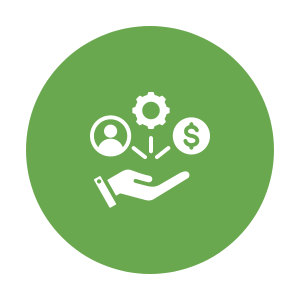
In this complete guide to Digital Asset Management System You’ll learn:
So if you’re ready to go “all in” with Digital Asset Management System, this guide is for you.
A digital asset management (DAM) system stands as the cornerstone of modern content organization, acting as the central nervous system for all your digital files. Throughout this chapter, I'll explain what exactly constitutes a DAM system, how it differs from common storage solutions, and why it's become essential for businesses drowning in digital content.
Digital asset management (DAM) is a comprehensive process for storing, organizing, managing, retrieving, and distributing digital files. At its core, it’s both a business process and an information management technology that creates a searchable, centralized repository where teams can efficiently access media assets.
The term “digital assets” refers to any branded digital content your company creates that’s subject to copyright protection. These assets typically include
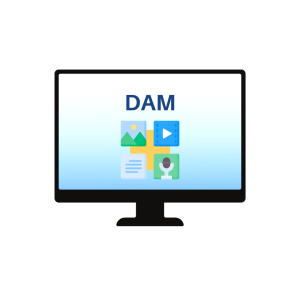 :
:
Essentially, a DAM system serves as a dedicated software solution that efficiently organizes your company’s complete digital content library. Unlike basic file storage, it provides controlled access to authorized stakeholders—including employees, clients, contractors, and partners—through a secure, centralized platform.
While cloud storage and DAM systems may appear similar at first glance, they serve fundamentally different purposes. Cloud storage primarily offers a place to save digital files online rather than on local computers or servers. File sharing tools like Dropbox mainly help individuals share large files without overloading email servers.
Digital asset management systems, on the other hand, are built around assets rather than individual users. This fundamental difference creates several key distinctions:
First, DAM systems provide a structured organization with advanced metadata capabilities. When you upload an asset to a DAM, you can add detailed metadata and tags that significantly enhance searchability. For example, if your sales team needs images from a specific marketing campaign, they can simply search using keywords like “marketing campaign” or specific campaign names without navigating complicated file paths.
Second, DAM solutions offer robust collaboration tools that cloud storage typically lacks. They enable automated feedback, review processes for new assets, and notifications for design approvals—making brand collaboration substantially more efficient. Furthermore, DAM systems track the production history of assets, preserving comments, rankings, and usage information during and after creation.
Third, DAM provides sophisticated access control through role-based permissions. Administrators can control how assets are shared based on roles, copyright status, campaigns, or file types. This ensures brand consistency while still allowing both internal and external users appropriate access.
Beyond basic file management, digital asset management systems offer numerous capabilities that transform how organizations handle their digital content. Primarily, they manage the entire lifecycle of digital assets—from creation and distribution to archiving, reusing, and retiring.
Most modern DAM platforms include built-in image and video editing features that accelerate content creation processes. This eliminates the need for additional software packages, potentially saving organizations significant money on separate editing tools.
Another crucial advantage is version control. DAM includes tracking capabilities that mark changes to assets and link different versions together. Through this versioning, DAM systems store the complete history of assets—past, present, approved, and not approved versions. When reusing an asset, users can access previous versions and make modifications rather than creating entirely new files from scratch, saving valuable time.
Perhaps most importantly, DAM provides valuable analytics that cloud storage systems simply don’t offer. It displays important statistics about media assets and generates reports demonstrating their performance. With these insights, teams can understand how users engage with digital assets, helping them streamline workflows, improve collaboration, and determine which types of content resonate most effectively with customers.
This analytical capability supports measurement of ROI for digital asset strategies—following the business principle that “if you can’t measure it, you can’t improve it”. By centralizing assets and providing these advanced capabilities, DAM systems enable organizations to find and reuse assets efficiently, driving significant production cost savings while reducing duplicate workstreams.
Digital asset management truly transforms how organizations handle their digital content, creating a cohesive system that extends far beyond simple file storage—delivering efficiency, consistency, and strategic value across the entire digital content lifecycle.
The digital universe is expanding at an unprecedented rate, with organizations amassing vast collections of digital content. To effectively navigate this digital landscape, we must first understand what constitutes a digital asset and the challenges associated with managing them.
Digital assets encompass far more than just ordinary files—they represent valuable content that can be owned, managed, and monetized. Traditional digital assets include photos, documents, videos, books, audio/music, animations, illustrations, manuscripts, emails, logos, and content pieces. These familiar formats form the backbone of most organizational content libraries.
Beyond these conventional types, the digital asset landscape has evolved to include blockchain-based assets such as non-fungible tokens (NFTs), cryptocurrencies, tokens, and even tokenized real estate or securities. Indeed, our lives have become increasingly digitized, with businesses and governments storing vast amounts of data and information that vary in value depending on their potential uses.
Moreover, digital assets can be classified based on their structure and characteristics. These classifications include NFTs (unique digital content linked to blockchain), stablecoins (digital currencies tied to another currency to minimize price volatility), and digital bonds (similar to conventional bond offerings with low risk and return).
Despite their value, digital assets present significant management challenges. Primarily, organizations struggle with clunky, chaotic workflows that hinder asset movement across business functions. For instance, an industrial manufacturer needs trackable assets—if a motor breaks down in a customer’s factory, sales representatives must quickly locate instruction manuals or replacement part images to prevent costly production stoppages.
Another pervasive issue is searchability—finding specific assets in vast repositories can be remarkably difficult. What should take minutes often takes hours as users manually sift through overwhelming search results. Consequently, systems become bogged down with “orphaned” assets that, despite being centralized, remain unused and effectively lost in the digital abyss.
Digital rights management presents yet another challenge, particularly for product manufacturers. Consider a hero image featuring a model whose contract lasts exactly two years—this single image might exist in 30 different locations across a digital ecosystem. When that contract ends, companies must locate, remove, and replace each instance—a monumental task without proper tracking systems.
Metadata—essentially “data about data”—serves as the fundamental solution to many digital asset challenges. In digital asset management, metadata provides descriptive information that makes content easier to place, retrieve, identify, and correctly use.
There are several types of metadata, each serving distinct purposes. Structural metadata reveals information about file origin, format, and configuration, including details like file name, format, size, creator, and creation date. Descriptive metadata, alternatively, stores details about the asset’s content, usage, and historical data, allowing for more efficient user searches. Administrative metadata encompasses preservation and rights management information, including terms of use, compliance requirements, and license expirations.
Tags, specifically, are labels placed on media assets to identify their content. For example, a beach photograph might have tags like “beach,” “palm tree,” “ocean,” or “sunset”. These tags eventually serve as search terms for team members, significantly improving searchability and enhancing the overall user experience.
Properly implemented metadata and tagging deliver numerous benefits, including improved asset reuse, reduced search time, prevention of data duplication, maintained brand consistency, optimized workflows, and reduced expenses related to recreating content. Hence, a DAM system is only as effective as its tagging setup—if people don’t follow the process, nobody will find the content, leading to the perception that “this system doesn’t work”.
Empower your business with global data synchronization; download our GDSN Buyer's Guide today and take the first step towards streamlined, accurate, and compliant product data management.
Every effective digital asset management system comes equipped with powerful features that transform chaotic file management into streamlined workflows. Let's explore the key components that make these systems indispensable for modern organizations.
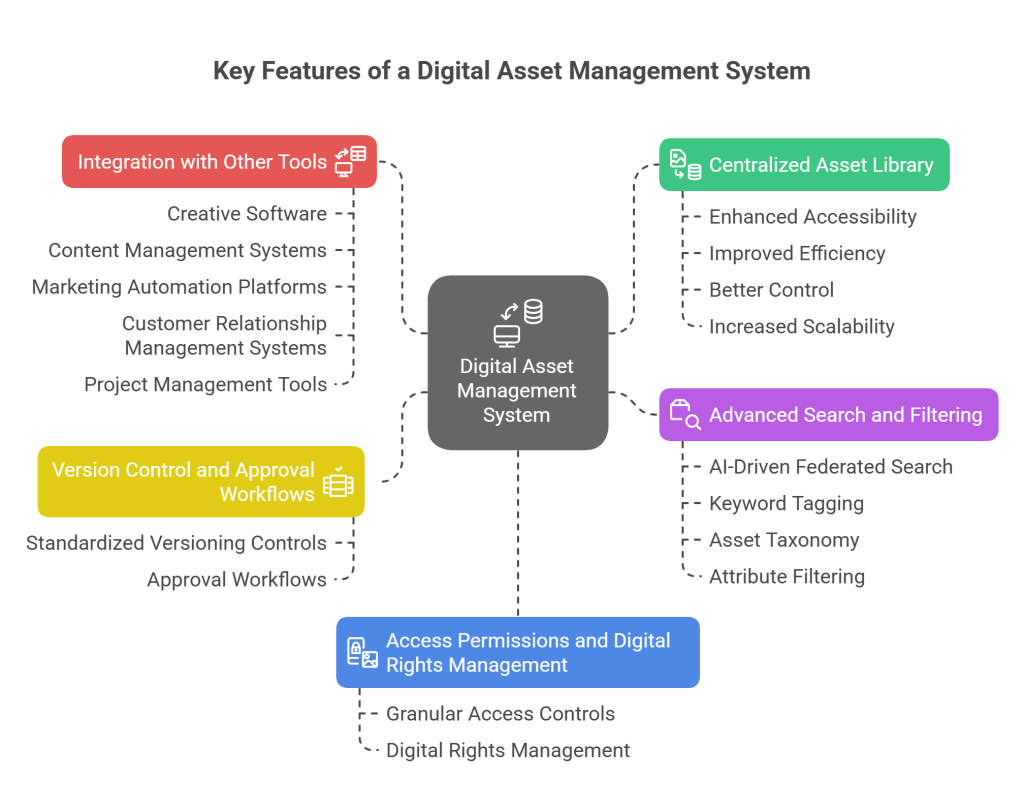
The foundation of any digital asset management system is its centralized repository—a unified storage system where all digital assets live. This single source of truth ensures everyone accesses the most current and accurate versions of assets while maintaining consistency and control.
A centralized asset library delivers significant benefits:
Unlike traditional file storage methods, this centralized approach eliminates content duplication and allows teams to extract additional value by repurposing existing content for other projects and regional adaptations.
The true power of a DAM system lies in its search capabilities. Advanced search functions transform how teams locate assets, making what should take minutes actually take minutes—not hours of manual searching.
Modern DAM solutions incorporate AI-driven federated search capabilities alongside keyword tagging, asset taxonomy, and attribute filtering. These features make finding the right assets quick and efficient, preventing workflow bottlenecks.
Some advanced search capabilities include:
Version control is crucial for maintaining order in collaborative environments. Rather than creating confusing file naming conventions (logo_final_FINAL_v2.jpg), DAM systems implement standardized versioning controls that track all asset iterations from a central platform.
This versioning capability stores complete histories of assets—tracking who made changes, when they were made, and why modifications occurred. Teams can easily access previous versions when needed rather than recreating assets from scratch, saving valuable time.
Additionally, approval workflows streamline review processes. Administrators can assign specific tasks to team members responsible for reviewing and approving content. These systems can even set up automated triggers that notify users once tasks are completed, ready to move to the next phase.
Security remains paramount when managing valuable digital assets. DAM systems provide robust security measures through granular access controls and permissions based on user roles.
Administrators can refine permissions for:
These controls ensure only authorized individuals can view, modify, or distribute digital assets. Furthermore, digital rights management capabilities enforce licensing terms, preventing unauthorized usage after rights have expired and protecting sensitive content with advanced watermarks.
Modern DAM solutions don’t exist in isolation—they connect seamlessly with core business applications. These integrations allow users to access and work with assets directly within their preferred applications.
Key integration possibilities include:
Through these connections, assets flow smoothly in upstream and downstream processes, resulting in faster production times and consistent brand messaging from prototyping to delivery. As a result, teams can work more efficiently without toggling between different platforms.
Empower your business with global data synchronization; download our GDSN Buyer's Guide today and take the first step towards streamlined, accurate, and compliant product data management.
Implementing a digital asset management system delivers tangible benefits that extend far beyond simple file organization. Companies investing in DAM solutions report impressive results across multiple business areas.
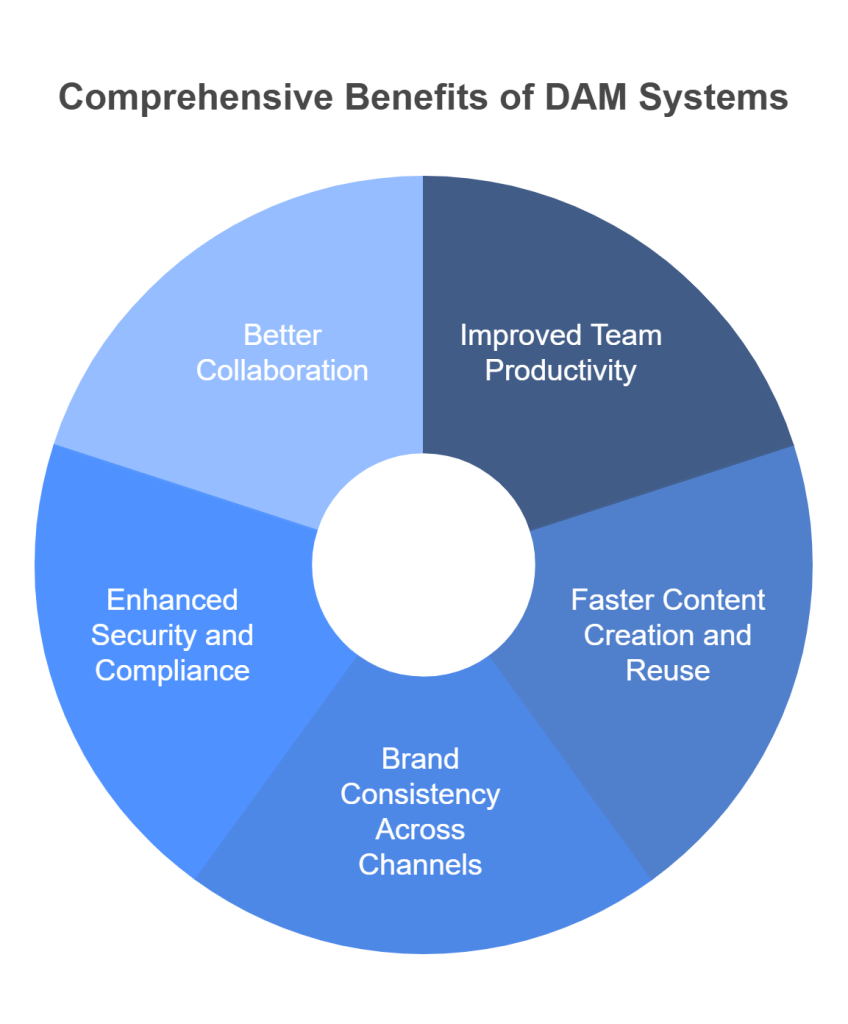
When digital assets are properly organized, teams can work significantly faster. Marketing automation through DAM systems has been shown to improve team productivity by 20% while reducing marketing overhead by 12.2%. This efficiency boost stems from:
In fact, organizations using DAM report a 49% increase in collaboration and efficiency. This productivity gain occurs because everyone can find what they need when they need it, without sending emails or waiting for file transfers.
Beyond improved search capabilities, DAM systems fundamentally transform how content gets created and distributed. Primarily, these systems help maximize content ROI by enabling teams to adapt existing assets for multiple use cases.
Organizations can automatically crop and distribute assets based on publishing channel specifications, allowing content to be distributed quickly across platforms. Additionally, when teams need to create new content, they can build upon existing assets rather than starting from scratch.
Similarly, the ability to repurpose content creates a multiplier effect on your content investment. As one resource notes, “By providing assets to be used and repurposed, more teams can publish on-brand content”, effectively democratizing content creation across your organization.
Maintaining consistent brand messaging becomes remarkably easier with a centralized DAM system. These platforms serve as the single source of truth for all brand assets, ensuring that outdated or unapproved versions aren’t accidentally circulated.
Version control features track all changes to assets, providing access to the latest versions and ensuring compliance with brand guidelines. Furthermore, DAM systems enable teams to create brand hubs—dedicated spaces where people can discover, understand, and correctly apply brand elements.
Notably, this consistency builds trust with customers. A uniform brand experience reassures them they’ll receive the same high-quality service regardless of how they interact with your company.
In today’s regulated environment, security and compliance are non-negotiable. DAM systems excel in both areas by providing:
For organizations in regulated industries, DAM systems help maintain compliance with frameworks like GDPR or other industry-specific regulations.
Effective collaboration remains crucial for today’s distributed workforce. DAM systems enable seamless teamwork through real-time collaboration features, feedback tools, and structured approval workflows.
These systems break down geographical and time-zone barriers—team members in different locations can access, comment on, and approve assets without delays. As a bonus, secure external sharing allows collaboration with agencies, freelancers and partners without compromising asset security.
Switch to Commport Datapool Solution. Our Datapool solutions include GDSN, PIM and PXM with built-in DAM features to help you centralize, store and distribute product data in real time to multiple channels simultaneously.
Selecting the right digital asset management system requires careful consideration of your organization's unique requirements. With numerous options available, finding the perfect solution demands a structured approach.
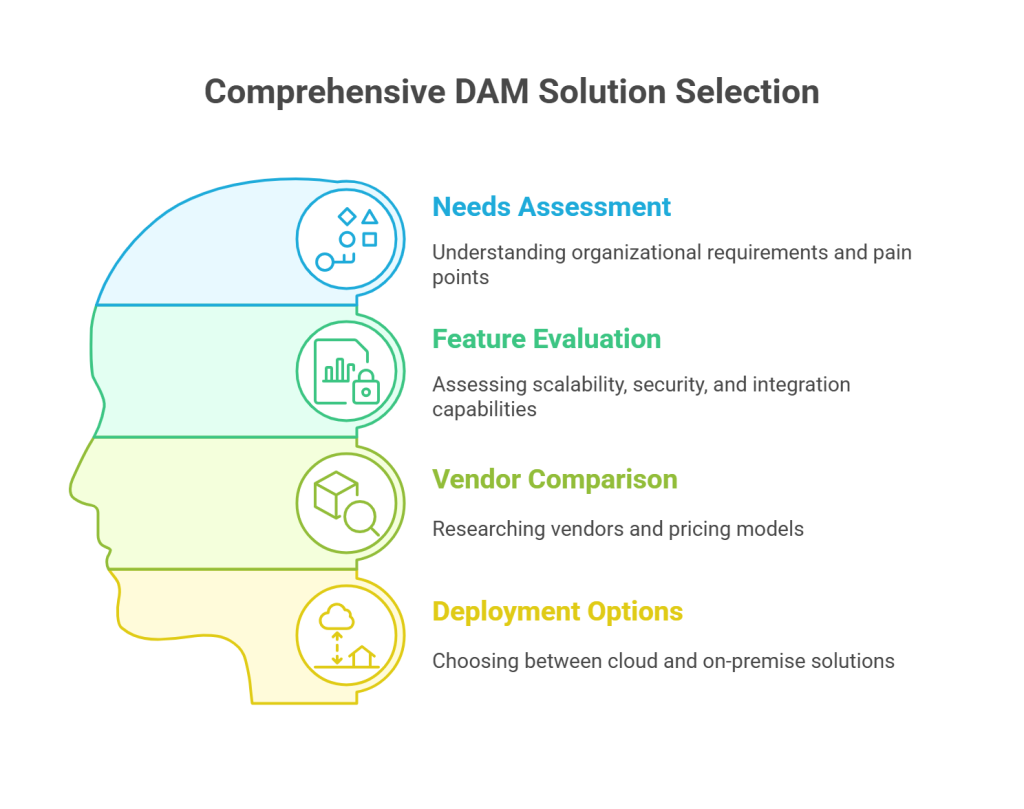
Prior to evaluating DAM solutions, conduct a comprehensive needs assessment. This process involves:
Understanding these fundamentals helps prioritize features that align with your workflow challenges. For instance, an organization managing thousands of videos requires robust video handling capabilities, while a multi-brand company might prioritize advanced permissions.
Beyond basic functionality, evaluate how a DAM system will grow with your business. Consider these aspects:
Scalability becomes particularly crucial as businesses expand—81% of companies now run at least one business application in the cloud to support growth.
When comparing vendors, thoroughly research options through:
Beware of hidden costs beyond subscription fees, including API usage fees, storage overages, premium features, and data migration expenses.
The choice between cloud and on-premise solutions significantly impacts implementation and long-term costs:
On-premise systems provide greater control but require substantial IT resources and higher upfront investment. Meanwhile, cloud-based solutions offer accessibility from any location, automatic updates, and a subscription-based pricing model.
For organizations with distributed teams, cloud DAM ensures collaboration regardless of geographical location. Furthermore, cloud DAM customers achieve ROI faster—in approximately 10 months compared to 14-17 months for competitors.
Switch to Commport Datapool Solution. Our Datapool solutions include GDSN, PIM and PXM with built-in DAM features to help you centralize, store and distribute product data in real time to multiple channels simultaneously. Synchronizing both retail and online channels offering omnichannel experience to customers.
Empower your business with global data synchronization; download our GDSN Buyer's Guide today and take the first step towards streamlined, accurate, and compliant product data management.
Successfully setting up a digital asset management system requires careful planning and ongoing attention. Once you've selected the right solution, the real work begins with implementation, training, and maintenance.
Implementing a DAM system involves strategic planning and execution through several critical phases. Initially, assess your digital asset requirements by evaluating content types, volumes, and prioritizing based on strategic importance. This foundational step allows you to create a comprehensive DAM strategy that aligns with your organizational goals.
Thereafter, choose the appropriate DAM solution that scales with organizational growth while maintaining robust performance. Through implementation, involving stakeholders from various departments is crucial for gaining buy-in and ensuring the system meets diverse needs.
A phased rollout approach minimizes disruptions and enhances user acceptance. Begin with a pilot phase involving a select group, then gradually expand to other teams while continuously refining based on real-world usage. Allocate sufficient budget not just for acquisition but also for ongoing expenses like training, support, and maintenance.
Effective DAM usage relies heavily on proper training. Arrange personalized educational sessions for each team member to ensure everyone understands how to configure and use the system according to their specific needs. This customized approach increases adoption rates and system effectiveness.
Develop role-specific training programs tailored to different user groups, addressing their unique workflows and responsibilities. Ongoing education and support are essential—provide resources like workshops, video tutorials, and interactive demos to engage users with varied learning styles.
According to data, only 30% of businesses successfully navigate through digital transformation when adding tools like DAM. Overcoming this challenge requires making training a high priority to optimize return on investment.
Digital asset governance systematically manages, controls, and optimizes assets throughout their lifecycle. Proper governance ensures the right assets are created and leveraged optimally across channels, maintaining brand consistency.
When establishing metadata management, develop a standardized schema that ensures consistency in how metadata is created, stored, and shared. Implement controlled vocabularies and taxonomies to reduce ambiguity and improve search accuracy.
Regularly review and update metadata to maintain its relevance and accuracy. Consider implementing automated metadata capture where possible, particularly for technical metadata like file format and creation date.
Calculating ROI provides clear financial measurement of your DAM system’s impact. Track metrics like time savings—for example, if four people each spend four hours weekly searching for assets at approximately $25 per hour, that’s $20,800 annually in potential savings.
Monitor user adoption through login rates, geolocation data, and system interaction patterns. Analyze search queries and keywords to optimize your system’s searchability and taxonomy.
Evaluate asset utilization by tracking views, downloads, and interactions with specific files. Additionally, measure search efficiency by assessing the time users take to find assets and the success rate of search queries.
Through these implementation and maintenance practices, your digital asset management system will continue delivering value long after initial setup.
Digital asset management systems truly transform how organizations handle their growing libraries of digital content. Throughout this guide, we’ve explored how DAM systems offer far more than simple file storage. Instead, they provide comprehensive solutions for the entire digital asset lifecycle.
First and foremost, a well-implemented DAM system creates order from chaos through centralized storage, advanced search capabilities, and robust version control. This centralization eliminates the frustration of searching through endless folders for specific files—a problem that plagues organizations of all sizes.
Additionally, the benefits extend beyond organization. Companies using DAM solutions report remarkable improvements in team productivity, with some seeing up to 49% increases in collaboration efficiency. The ability to quickly find, reuse, and repurpose existing assets multiplies the return on your content investments while maintaining brand consistency across all channels.
Choosing the right DAM solution, however, requires careful consideration. You must thoroughly assess your organization’s specific needs, evaluate essential features, compare vendors, and decide between cloud and on-premise options. This decision directly impacts both implementation success and long-term value.
After selecting a system, successful implementation depends on strategic planning, comprehensive training, and ongoing governance. Proper metadata management serves as the foundation for searchability and usability, while measuring ROI helps justify the investment and identify areas for improvement.
Undoubtedly, the digital universe will continue expanding at an unprecedented rate. Organizations that implement effective digital asset management now position themselves to handle this growth efficiently. Rather than drowning in disorganized files, they can focus on creating value through their digital assets.
Remember, a DAM system is more than just technology—it represents a strategic approach to managing your digital content. When properly implemented, it becomes the backbone of your digital operations, enabling teams to work more efficiently while maximizing the value of every asset you create.
Switch to Commport Datapool Solution today. Our solutions include GDSN, PIM and PXM with built-in DAM features to help you centralize, store and distribute product data in real time across multiple channels simultaneously.
A Digital Asset Management system is a comprehensive solution for storing, organizing, and distributing digital files from a centralized repository. It goes beyond simple file storage by offering advanced features like metadata tagging, version control, and workflow management.
While cloud storage primarily offers file storage and basic sharing, DAM systems provide advanced organization, searchability, and collaboration features. DAM includes metadata management, version control, rights management, and integration with other business tools, making it more suitable for managing large collections of digital assets.
Implementing a DAM system can lead to improved team productivity, faster content creation and reuse, enhanced brand consistency across channels, better security and compliance, and improved collaboration among internal and external teams. Some organizations report up to 49% increase in collaboration efficiency.
Selecting the right DAM solution involves assessing your organization’s specific needs, evaluating key features and scalability, comparing vendors and pricing models, and deciding between cloud-based and on-premise systems. It’s important to consider factors like integration capabilities, security features, and potential for growth.
Successful DAM implementation involves strategic planning, a phased rollout approach, comprehensive training and onboarding for team members, establishing ongoing asset governance and metadata management practices, and regularly measuring ROI and system performance. Proper implementation is crucial for maximizing the value of your DAM investment.